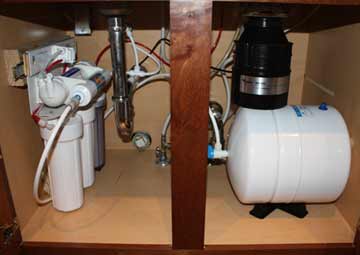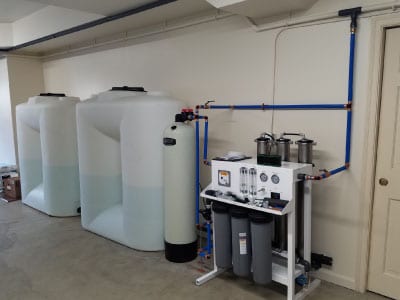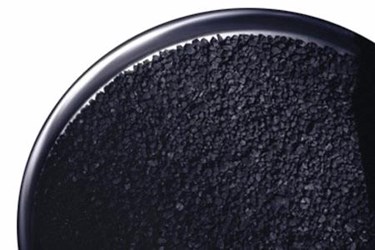Do you have PFAS in your drinking water? If so, you’re probably concerned about your health and looking for ways to remove it. Reverse osmosis is often used to treat PFAS, but how well does it actually work?
Reverse osmosis is a proven technology for treating PFAS contaminated drinking water. It removes more than 99% of PFAS from water and is better at removing the smaller molecules in this class of contaminants than activated carbon or ion exchange resins. Although it is expensive, RO is simple to operate and can reliably produce clean drinking water.
Continue reading to learn more about reverse osmosis and treating PFAS in your drinking water.
Table of Contents
What Exactly is PFAS
PFAS compounds are a class of man-made chemicals that have been used in the manufacturing of many different household products, such as food packaging and nonstick cookware. These compounds can also be found in firefighting foam and other industrial settings where they might encounter water. PFAS is short for per- and polyfluoroalkyl substances which means that it contains both fluorine atoms and carbon chains.
The EPA has established a lifetime health advisory level at 70 parts per trillion (ppt) for two specific types of PFAS – perfluorooctane sulfonic acid (PFOS) and perfluorooctanoic acid (PFOA). This level represents a single drop in 20 Olympic-sized swimming pools.
Unfortunately there is currently no limit on how much of these contaminants can be in drinking water and it has been found at varying levels throughout the country. Without regulation from the EPA or state agencies, citizens are left without guidance about their safety.
PFAS in Drinking Water: Reverse Osmosis as a Water Treatment Method
Reverse osmosis is a proven technology that has been used for decades to treat water contaminants. The process works by pushing the contaminated water through a semi-permeable membrane which filters out pollutants and impurities from entering your drinking supply. It removes more than 99% of PFAS from water and is better at removing these contaminants than activated carbon or ion exchange resins.
What is reverse osmosis
Reverse osmosis is a process that uses pressure to force water through a semi-permeable membrane, which filters out contaminants. This technology uses a filter membrane with small pores to remove a variety of contaminants.
RO has been used in drinking water for years and is the most common form of treatment for PFAS in drinking water. Reverse osmosis can remove up to 99% of some types of PFAS, including shorter chain ones like the more problematic PFOA and PFBS (which have been found in our drinking supply).
Reverse osmosis relies on the permeability of the membrane surfaces to remove contaminants. A typical membrane has a pore size of 0.0001 microns. This is an incredibly small hole.
Typical PFAS molecules have a maximum diameter of 2 nanometers, or 0.002 microns. This is more than 10 times larger than the openings in an RO membrane. As water containing PFAS is pumped through the membrane, the large fluorinated molecules are filtered out. Water simply passes through the membrane and exits as treated water.
RO systems continuously recycle water through the membrane. This concentrates the waste into a much smaller volume – typically 20% of the raw water volume. Eventually, the waste becomes very concentrated with PFAS and other molecules that are filtered out. This concentrated solution is called brine.
Contaminants removed by RO
Reverse osmosis removes a lot of different contaminants in addition to PFAS. Compounds removed by RO include:
- lead
- arsenic
- chlorine
- heavy metals
- mercury
- pathogens (bacteria and viruses)
- nitrates
- pesticides
- sulfates
- fluoride
- pharmaceuticals
Under sink reverse osmosis filter

Here is the undersink reverse osmosis filter I installed in my kitchen. You may interested in something similar for your home.
Check Pricing on Amazon
Testing Your Drinking Water for PFAS
Simple Lab has created a comprehensive kit that allows you to test for 14 different types of PFAS compounds in your drinking water. Their kit is easy-to use – just follow the instructions by filling the sample jar with water and ship it back to them. Within a week or two, they provide you with a comprehensive report listing every compound they tested for and the results. They also explain what the results mean, including whether you need to be concerned for your family’s health.

How well does reverse osmosis work for PFAS treatment
Reverse osmosis is a proven technology that has been used for decades. It removes more than 99% of PFAS from water and is better at removing these contaminants than activated carbon or ion exchange resins. Although it is expensive, it is simple to operate and can reliably produce clean drinking water.
Some people prefer to use activated carbon or ion exchange resins for water purification because they are less expensive and easier to maintain. However, these treatments have been shown to be less effective at removing PFAS from drinking water when compared with reverse osmosis. These adsorption technologies are not as effective at removing the short chain molecules that are more widely used today.
Duke University conducted a study of treatment systems at homes with PFAS in their drinking water. Their research showed that reverse osmosis filters remove almost all PFAS in drinking water. This type of treatment system performed much better than activated carbon. This study also demonstrated that under-sink POU RO systems performed just as well as larger, whole-house systems.
Reverse osmosis is an “extremely effective” method for removing PFAS.
Different Types of RO Systems to Remove PFAS
Homeowners can choose between point-of-use filters or whole-house systems. POU RO systems are small and made to attach directly under a kitchen faucet. Larger, whole-house filtration systems treat all incoming water for the home. This ensures that all water, regardless of where it is, is safe to drink.
Point-of-use reverse osmosis systems

You can use a point-of-use RO system to treat water where it is consumed. Typically, this is an under sink filter that is installed in the kitchen. This setup provides treated drinking water from the kitchen faucet. Check out my guide to under-sink RO filters.
An under-sink RO filter integrates with the plumbing under your kitchen sink to provide treated drinking water for you and your family. The concentrated PFAS brine is discharged directly down the drain, so there is not waste to manage or dispose of.
A tankless reverse osmosis system is a great choice for people who have smaller homes with limited storage space. Tank systems typically take up more space under your sink, while this new technology eliminates the tank altogether.
A POU RO system uses a combination of cartridges. Usually, these systems include a particulate filter, a carbon filter (optional), and the reverse osmosis membrane cartridge.
Whole house reverse osmosis systems

Many homeowners opt for a whole-house reverse osmosis system. The RO unit is installed at the point where your home’s water supply enters. The system treats all incoming water and ensures that you have clean drinking water throughout your house.
Whole-house reverse osmosis systems consist of four major components: a prefilter, sediment filter, reverse osmosis membrane cartridge, and carbon postfilter.
Some systems use an additional filter cartridge outside the membrane. This is called a polishing filter, and it filters out any remaining contaminants after passing through the RO membrane.
These complex systems ensure that you have safe water at every tap in your home. Your appliances will also work better because there are no minerals or other particles to clog.
I wrote a comprehensive guide on whole house reverse osmosis systems that discusses everything you want to know.
Installation considerations
For those looking to install a reverse osmosis system under their kitchen sink, it’s important to factor in some plumbing factors. For starters, these RO filters take up a significant amount of space. If this is a DIY project, make sure to measure under you sink and then compare that to the dimensions of the filter.
Also, check for an available outlet. Some (not all) RO filters require electricity.
Another important consideration with under-sink RO filters is they require a separate faucet. This additional faucet has to be installed through the sink or your countertop – this requires drilling a hole plus all of the additional plumbing.
RO systems require high pressure to work (50 psi), and most homes have about 30 to 80 pounds per square inch of water pressure. This is needed to force the water through the various filters that remove the impurities.
If your house has low water pressure, you’ll need a booster pump. Pumps require a separate power supply plus additional plumbing. Even if you have good water pressure, the RO system will perform better with higher pressure.
The Downside of Reverse Osmosis Water Treatment
Reverse osmosis treatment systems have a number of drawbacks that you should consider before installing one in your home.
Typically, they require pre-filtration to remove any sediment and small particles from the incoming feed. If not removed, suspended particles can clog the membrane or even damage them. Filtration is another cost and maintenance item.
The membranes must be replaced periodically. Most home systems use a cartridge that you (or a service technician) remove and then install a new one. A typical filter can cost $100 to more than $400 depending on the size of your system and the brand you have.
The purchase price of a reverse osmosis system is high. A point-of-use (POU) RO system costs between $400 and $700. This type of system is installed under your sink and treats water that comes out of the faucet.
A whole house system can cost several thousand dollars to purchase. This type of unit must be installed by a plumber.
Reverse osmosis systems waste a lot of water. For every 10 gallons of untreated water, as much as 7 to 8 gallons are dumped drown the drain. You end up with just 2 to 3 gallons of drinking water. That’s a lot of wasted water!
In addition to removing PFAS from your water, these filters also remove chlorine. If you have a whole house filter, you may have bacteria growing in your pipes. This isn’t an issue if you have an under-sink unit.
RO systems create PFAS waste
RO filters end up concentrating the waste in a high-strength brine. Depending on the type of membrane and the manufacturer, approximately 20% of the raw water that enters the filter ends up as concentrated waste. This waste is problematic because it has high levels of PFAS in it.
Residential reverse osmosis systems simply dump this waste down the drain. Houses that have septic systems should connect the RO discharge line to a storage tank to avoid polluting groundwater. In most cases, these houses get their drinking water from a well, which is groundwater. If the house is connected to a public sewer system, this solves the problem for the homeowner. However, most municipal sewage treatment plants aren’t able to treat PFAS waste
Commercial and industrial filters store it – this requires disposal and other management requirements which can be expensive.
Alternatives to Reverse Osmosis
As noted above, RO systems have been extremely effective at removing PFAS. Granular activated carbon and ion exchange resins can also be used to remove PFAS from drinking water.
Activated carbon is a porous material that can be used to remove organic molecules from water. It has been shown to remove PFAS, although may not efficiently treat the shorter chain compounds which were developed as alternatives to these toxic chemicals. GAC is a very effective technology for PFAS removal.
Ion exchange resins also rely on specific chemical interactions with contaminants to bind them to the resin surface. Ion exchange resins have been shown to remove PFOA and PFOS from drinking supplies as well as some of the new PFAS compounds like GenX which may be in your water supply.
Ion exchange treatment of PFAS
The ion exchange process is an efficient technology for the remediation of PFAS water. Studies have shown that two-stage filters reduced PFAS levels significantly.
Ion exchange is a process that uses specific resins to remove contaminants through chemical interactions. The resin binds the PFAS compounds, leaving purified drinking water behind. Over time, the resin becomes saturated and must be replaced with fresh media.
Activated carbon treatment of PFAS

Activated carbon treatment has been studied for the removal of perfluorinated chemicals, and researchers have found that it is both cost-effective and efficient in removing these harmful pollutants. Many brands of carbon can remove typical levels of PFOA and PFOS to non-detect levels.
The EPA reports that activated carbon can remove 99% of PFOA and PFOS, with rates varying for other compounds. For other compounds, the removal rates vary from 77 to 99%.
Read my article Do Carbon Filters Remove PFAS and GenX Chemicals for more information.
FAQs about PFAS and Reverse Osmosis Treatment
What are the drawbacks to treating water by reverse osmosis?
One of the major disadvantages to having an RO system at home is that it will remove most of the minerals from your water. This can reduce the pH levels, making your water acidic. The minerals that are removed are beneficial to your health. Many whole-house RO systems include a re-mineralizer to add these compounds back. Another downside to reverse osmosis – during each purification process, up 20 gallons or more can be flushed down the drain for every one gallon produced by this type of system!
Does my Brita filter treat PFAS?
Brita filters are not suitable for removing PFAS from drinking water. They can remove some of the PFAS compounds, but not all of them. In addition, if you don’t maintain the filter, the water quality can often become worse. Pitcher filter systems water treatment is fine for taste and odor, but not health-related contaminants.
What is a safe level of PFAS in my tap water?
The EPA recommends that water supplies should not have more than 70 parts per trillion of PFAS. There is no federal drinking water standard. Most states have established drinking water standards. California has the lowest – 5.1 ppt.
Obviously, you don’t want any PFAS in your drinking water. This is why a reverse osmosis water treatment system is a good option for many people.
Can I test my water for PFAS?
You can test your drinking water for PFAS and other contaminants. There are no simple tests, like test stripes, that check for PFAS. However, you can order a sample kit from several laboratories and they will analyze your water.
These test range in price from $70 to over $500. The typical price for testing drinking water for PFAS is $350. As the science improves, the cost of these tests will decrease.
What are the results of the North Carolina study?
Duke University conducted an extensive study of PFAS in drinking water in several communities in North Carolina. They found extensive PFAS contamination in many potable wells and public water supplies. The Environmental impact of PFAS releases is a significant problem in the US.

